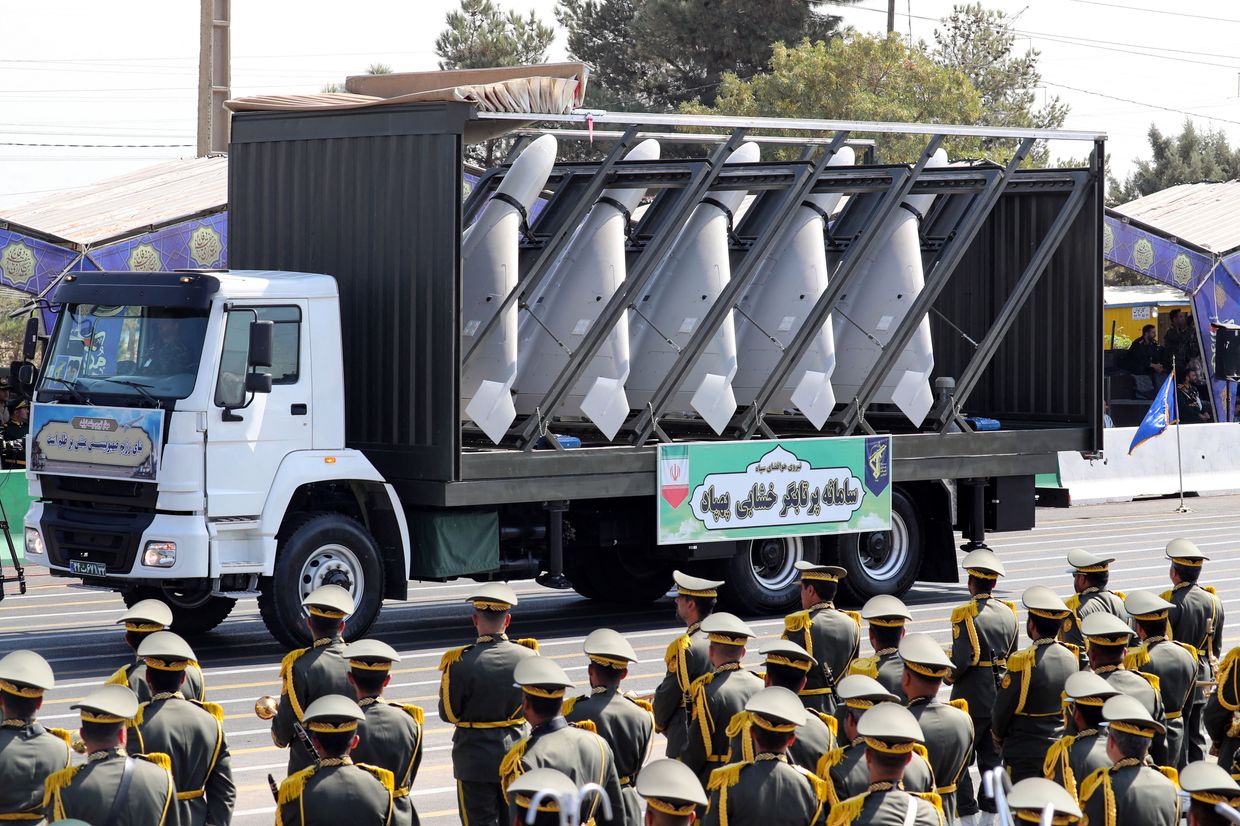
Russia reportedly uses new 'Oreshnik' ballistic missile against Ukraine — what we know so far
Russian President Vladimir Putin delivers a televised address to the nation at the Kremlin in Moscow on Nov. 21, 2024. Putin said that the country's forces hit Ukraine with a new intermediate-range ballistic missile. (Vyacheslav Prokofyev/POOL/AFP via Getty Images)
Russia launched a new type of intermediate-range ballistic missile (IRBM) against Dnipro, east Ukraine on the morning of Nov. 21, Russian President Vladimir Putin has said.
Initially, Ukraine's Air Force reported the attack had been carried out by an intercontinental ballistic missile (ICBM), though some Western officials later cast doubt on the claim and said it was an IRBM, not an ICBM, Reuters reported.
Late on Nov. 21, Putin said in a televised address that the attack was a test of Russia's "newest missile," an IRBM called "Oreshnik."
"In combat conditions, a test was carried out of one of the latest Russian intermediate-range missile systems. In this case, with a non-nuclear hypersonic version of a ballistic missile," he said.
A U.S. official speaking on condition on anonymity later confirmed to the Kyiv Independent that Russia launched "an experimental intermediate-range ballistic missile against Ukraine."
What happened during the attack?
In the early hours of Nov. 21, a country-wide air raid alert sounded due to the threat of ballistic missiles, and later, the launch of several Russian Tu-95MS bomber aircraft.
According to Ukraine's Air Force, the attack targeted the city of Dnipro using a number of different missile types.
"In particular, an intercontinental ballistic missile was launched from the Astrakhan region of the Russian Federation, an Kh-47M2 'Kinzhal' aeroballistic missile from a MiG-31K fighter jet was launched from the Tambov region, and seven Kh-101 cruise missiles were fired from Tu-95MS strategic bombers," the report said.
The report did not specify what type of ICBM was launched. Astrakhan Oblast is located in southern Russia, over 700 kilometers (435 miles) east of Dnipro. The region borders Kazakhstan, Russia’s Kalmykia Republic, Volgograd Oblast, and the Caspian Sea.
An industrial enterprise was damaged, and two fires broke out in the city, Governor Serhii Lysak said. A rehabilitation center for people with disabilities was damaged in the attack, Mayor Borys Filatov said.
At least two people are reported to have been injured.
Ukraine's Air Force said six of the Kh-101 missiles were reportedly shot down, but did not say if the reported missile had caused any of the damage in Dnipro.

What is an intermediate-range ballistic missile?
Russia regularly uses close, and short range ballistic missiles in aerial attacks against Ukraine, but IRBMs and ICBMs are far larger, can be equipped with nuclear payloads, and are designed to hit targets at far longer ranges.
Ballistic missiles are rocket-powered and are launched high into the atmosphere before arcing back down onto their target.
They're only guided during the initial stages of launch, so they can be less accurate than cruise missiles, but have the advantage of reaching incredibly high speeds — sometimes more than 3,200 kilometers per hour — as they approach their targets.
Crucially, ballistic missiles also have a very long range — anything from around 1,000 kilometers, to 3,000-5,500 kilometers, in the case of IRBMs.
Until now, Russia has used several models of shorter-range ballistic missiles, including the Iskander and the Kinzhal. Due to their high speed, only certain air defense systems are capable of shooting them down, the U.S.-made Patriot system being one of them.
What sort of missile did Russia launch?
Little is known about the "Oreshnik" missile referred to by Putin, but military expert Yan Matveev told IStories that it could be a modified version of the Rubezh.
The RS-26 Rubezh intercontinental ballistic missile is reported to have a range of up to 6,000 kilometers, can carry four warheads each with an estimated payload of 0.3 megatons.
Fabian Hoffmann, a defense expert and doctoral research fellow at the University of Oslo, told the Kyiv Independent that Rubezh is equipped with a MIRV payload, which stands for Multiple Independent Reentry Vehicles.
Purported footage of the attack shows multiple projectiles hitting the ground, but without the large explosions normally associated with conventional missiles or payloads.
"So this strike is not for military value, this is purely, purely for political purposes," he added.
What are those political purposes?
The attack came in the wake of what appeared to be Ukraine's first successful strike of a military target inside Russia using the U.S.-supplied ATACMS missiles.
After depicting such a move as crossing another "red line" the Kremlin had drawn, Russian President Vladimir Putin said his country would respond.
"They probably considered testing a nuclear warhead, which was also rumored to happen soon, but decided that's too intense, and that could invite too much backlash, especially from partners, such as China and India," Hoffman said.
"And then they probably thought that this is the next best option, because it sends a clear signal to the West, while potentially not antagonizing critical international partners."
The U.S. official told the Kyiv Independent that "Russia likely possesses only a handful of these experimental missiles."
What has Kyiv, Moscow said?
As well as the original Air Force statement, in the early afternoon of Nov. 21, President Volodymyr Zelensky said an examination was taking place to determine the exact type of missile, but "all characteristics" of the strike had "intercontinental ballistic capabilities."
"We can see that Putin is using Ukraine as a training ground," he added.
Initially, Russia said very little about the attack. When asked if Moscow had fired an ICBM, Kremlin spokesman Dmitry Peskov told reporters he had "nothing to say on this topic."
In a video clip widely shared in the media, Russian Foreign Ministry spokesperson Maria Zakharova received a phone call during a press conference apparently asking her not to comment on reports about "ballistic missile strikes."
Zakharova later claimed she was merely asking "experts whether this was our topic," and the "answer came during the briefing: the Foreign Ministry does not comment. There is no conspiracy."
Referencing Ukrainian strikes inside Russia using Western-supplied ATACMS and Storm Shadows, Putin later said the attack was "in response to the use of American and British long-range weaponry on Nov. 21 this year."
He said the test "was successful" and that "one of the largest industrial complexes known since the Soviet era has been hit on Ukraine’s territory."
"There are currently no ways of countering this weapon. The missiles attack targets at a speed of 10 Mach, that’s 2.5-3 km per second," he said.
"We are ready for any developments. If anyone still doubts this, they shouldn’t. There will always be a response."
What has the international community said?
Russia using an intercontinental ballistic missile (ICBM) against Ukraine would be a "clear escalation" by Moscow, EU foreign affairs spokesperson Peter Stano told reporters on Nov. 21.
"While we're assessing the full facts, it's obvious that such (an) attack would mark yet another clear escalation from the side of (Russian President Vladimir) Putin," Stano said, according to AFP.
The U.S. official told the Kyiv Independent that while "we take all threats against Ukraine seriously, it is important to keep a few key facts in mind."
"Ukraine has withstood countless attacks from Russia, including from missiles with significantly larger warheads than this weapon.
"Let me be clear: Russia may be seeking to use this capability to try to intimidate Ukraine and its supporters, or generate attention in the information space, but it will not be a game changer in this conflict."
Later on Nov. 21, Defense Department Deputy Spokesperson Sabrina Singh, said Russia gave the U.S. a brief advance warning of the strike.
“The United States was pre-notified briefly before the launch, through nuclear risk reduction channels," Singh said.
The warning, sent 30 minutes before the launch, was also confirmed by Kremlin spokesperson Dmitry Peskov.
How can Ukraine intercept intercontinental ballistic missiles?
Ukraine's U.S.-supplied Patriots have been effective at intercepting the ballistic missiles launched by Russia to date, but according to Defense Express, they are not currently optimized to intercept ICBMs.
If Russia began to regularly launch ICBMs, Ukraine's air defenses would need to be bolstered by more advanced air defense systems like the THAAD (Terminal High Altitude Area Defense), the outlet reported.














